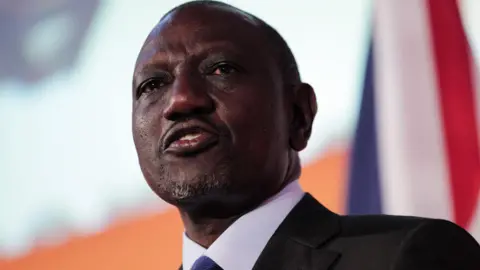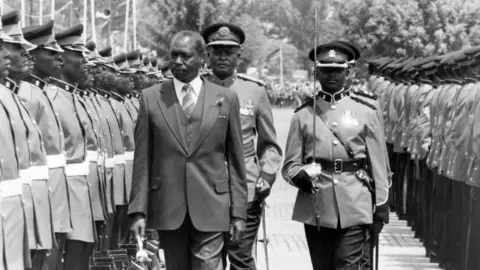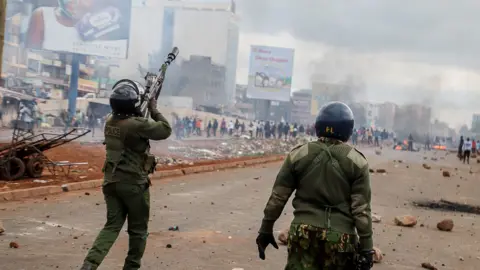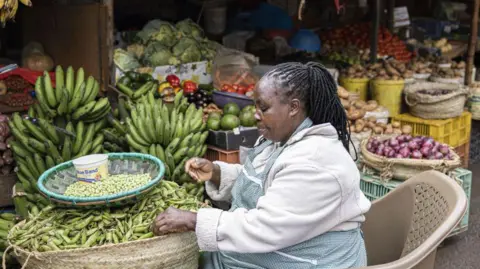BBC News, Nairobi
 Bloomberg via Getty Images
Bloomberg via Getty ImagesKenya’s William Ruto rode into office on a wave of enthusiasm among ordinary people who hoped he would live up to his promises to improve their lives. Instead, he is facing unrelenting criticism – seen as unmatched in the country’s history.
Seemingly frustrated by the intensity of the backlash, he on Wednesday asked why such public outrage was never directed at his predecessors, including Daniel arap Moi, who ruled with an iron fist for over two decades marked by political repression and human rights abuses, and others who departed under clouds of controversy.
On Wednesday Ruto posed: “All this chaos, why wasn’t it directed at [former presidents] Moi, Mwai Kibaki, Uhuru Kenyatta…Why the contempt and arrogance?”
Analysts describe the current wave of public anger toward President Ruto, which has seen more than 100 people killed over the past year, as “unprecedented”, uniting Kenyans across ethnic, religious, and class divisions.
Protests against his administration began barely a year after he came into power. Three years in, many aggrieved Kenyans now want him gone – amid unrelenting protests with rallying calls of “Ruto must go” and “Ruto Wantam” (Ruto for one term).
When Ruto was vying for the presidency, he portrayed himself as a common man, who came from a childhood marked by poverty and resilience. He appealed to the ordinary folk as a person they could draw inspiration from – having risen from chicken seller to president.
Contrast that to earlier this year, when a newspaper splashed a headline asking whether Ruto was “Kenya’s most hated president”, a sentiment that has often echoed across social media platforms and public discourse.
It marks an extraordinary change in Kenyan politics, often shaped by ethnic allegiances and class divisions. Just as Ruto was seen as transcending those barriers to clinch the presidency, the same dynamics now appear to be working against him.
This week the phrase “We are all Kikuyus,” trended on social media as young people rejected attempts to reintroduce the ethnic divisions that have long plagued Kenyan politics. A counter narrative of “We are all Kenyans” emerged but failed to gain similar traction – with some seeing it as an attempt to dilute the expression of solidarity in the first message.
The Kikuyu, Kenya’s largest ethnic group from the Mt Kenya region, overwhelmingly backed Ruto in the 2022 elections, together with Rigathi Gachagua, who hails from the region, as his deputy.
But Gachagua’s hounding from office last year through a dramatic impeachment process, which he described as a betrayal, sparked discontent in the region. In the aftermath, some politicians allied to Ruto have accused Kikuyu elites of fuelling opposition against the president.
Political analyst Mark Bichachi says the opposition to the president is not ethnically driven, but is happening across diverse communities in urban and rural areas.
He terms the “public outcry against a president and a regime” both “unprecedented” and “historical”, even surpassing the political upheavals of the 1980s and 1990s when Moi led a one-party state.
The period was marked by brutal crackdowns and a bloody fight for multiparty democracy, but Mr Bichachi tells the BBC that this did not generate the kind of pressure now bearing down on Ruto, adding that the tensions then were linked to the Cold War and were felt across the continent.
But academic Dr Njoki Wamai says the criticism levelled at the president is nothing unusual, but part of a political tradition during moments of crisis.
“All presidents, when they’ve gone against the constitution, against the will of the Kenyan people, have always faced a lot of criticism,” she tells the BBC.
She points to past leaders such as the founding president Jomo Kenyatta and his successor Moi – who both faced an intense backlash and loss of public trust during critical moments – including after the assassination of key political leaders and the coup attempt against Moi in 1982.
 Gamma-Rapho via Getty Images
Gamma-Rapho via Getty Images“What is different [this time] is that the scale of spread of information is higher,” she says, noting the impact of Kenya’s digitally savvy youth, whose widespread access to social media and digital tools has amplified public discourse.
She also describes Ruto as always having been “very conservative,” suggesting that his political outlook clashes with the more liberal values embraced by many Kenyans – particularly young people.
This ideological mismatch, she argues, has contributed to growing tensions.
The current resistance campaigns are largely youth-led, online-based, decentralised and seen as leaderless, mostly unfolding outside the established political class. Since last year, they have been driven by anger over the high cost of living, aggressive taxation, corruption and police brutality.
But pointing to ethnic politics and incitement as fuelling the latest unrest, the president said on Wednesday: Let’s stop ethnic division, hatred, pride and contempt. We are all Kenyans”.
He vowed to use “whatever means necessary” to maintain peace and stability. He called on the police to shoot in the legs protesters who were targeting businesses, rather than killing them. His remarks sparked more outrage and mockery.
Since last year, the Kenyan government has responded to protests and dissent with brutal crackdowns, including mass arrests and alleged abductions by security operatives.
 Getty Images
Getty ImagesIt is a strategy that rights groups say has only deepened public outrage and alienated the citizens from the state, with the police accused of using excessive force to quell the protests.
More than 100 people have been killed in successive waves of anti-government protests since June last year. The latest one on Monday claimed 38 lives, marking the deadliest day of unrest yet.
Rather than serve as a catalyst for police reform or push efforts to pacify the demonstrators, the deaths have often served as a spark for subsequent protests, turning grief into rage.
The government has blamed the violence on protesters, accusing them of attacking police stations and even trying to stage a coup.
Political communication expert Dr Hesbon Owilla calls the unrest “probably the most intense outrage against a regime” in Kenya’s history. He says it has brought people from all walks of life to unite in defiance.
He puts it down to how the president communicates to the people. He says Ruto’s promises to uplift the fortunes of ordinary people were “real, extremely real” and shifted the campaign from ethnic mobilisation toward issue-based politics.
“Then he became president. We are still waiting. What Kenyans are experiencing is worse,” he tells the BBC, capturing the deep sense of disappointment among many Kenyans.
He says that unlike past governments that made cautious promises, Ruto made, and continues to make, sweeping pledges leading to broken expectations.
“The disillusionment is creating the rage,” he says.
 Bloomberg via Getty Images
Bloomberg via Getty ImagesCiting the example of the order to shoot protesters, he also says that the president often speaks when silence might serve him better – overexposing himself and inadvertently making serious national issues feel personal.
As a result, when there is criticism, it tends to be directed squarely at him, rather than being attributed to a failure of governance systems.
Even so, Ruto has repeatedly highlighted his administration’s efforts to better the lives of all Kenyans, pointing to the government’s flagship affordable housing project, a universal health scheme, digital jobs, and an overseas employment programme as key achievements.
While inspecting one of the housing sites this week, he acknowledged the severity of youth unemployment but emphasised that the problem predates his presidency.
He insisted that his government was the first to take deliberate steps to tackle the crisis, citing state initiatives such as the housing project that he says has created hundreds of thousands of jobs.
The president appealed for patience, as the problem would take time to resolve.
Yet patience, especially amid the high cost of living, unmet expectations, and growing frustration, is not something that most Kenyans feel they can afford.
Some of those flagship programmes have come at a steep cost to Kenyans, who now have 1.5% housing levy and a 2.75% health insurance tax deducted from their monthly incomes. The pain of paying some of these higher taxes has dominated everyday conversations, especially with a perception that higher taxes have not resulted in better public services.
To the government’s credit, Dr Owilla says some of the initiatives, like the universal healthcare project, have had a great impact, and others may eventually deliver for many.
But Mr Bichachi argues that the government has “lost touch with how people feel”, and its tone has remained unchanged despite rising public resentment.
He says the issue is unlikely to change based on how the government performs – describing it as a “love-hate relationship” between the people and the presidency.
That is “how we find ourselves where we are”, he concludes, referring to the intense resentment that is now faced by the president, who was once one of the “the most applauded and lauded leaders to come onto the Kenyan state”.
You may also be interested in:
 Getty Images/BBC
Getty Images/BBC


